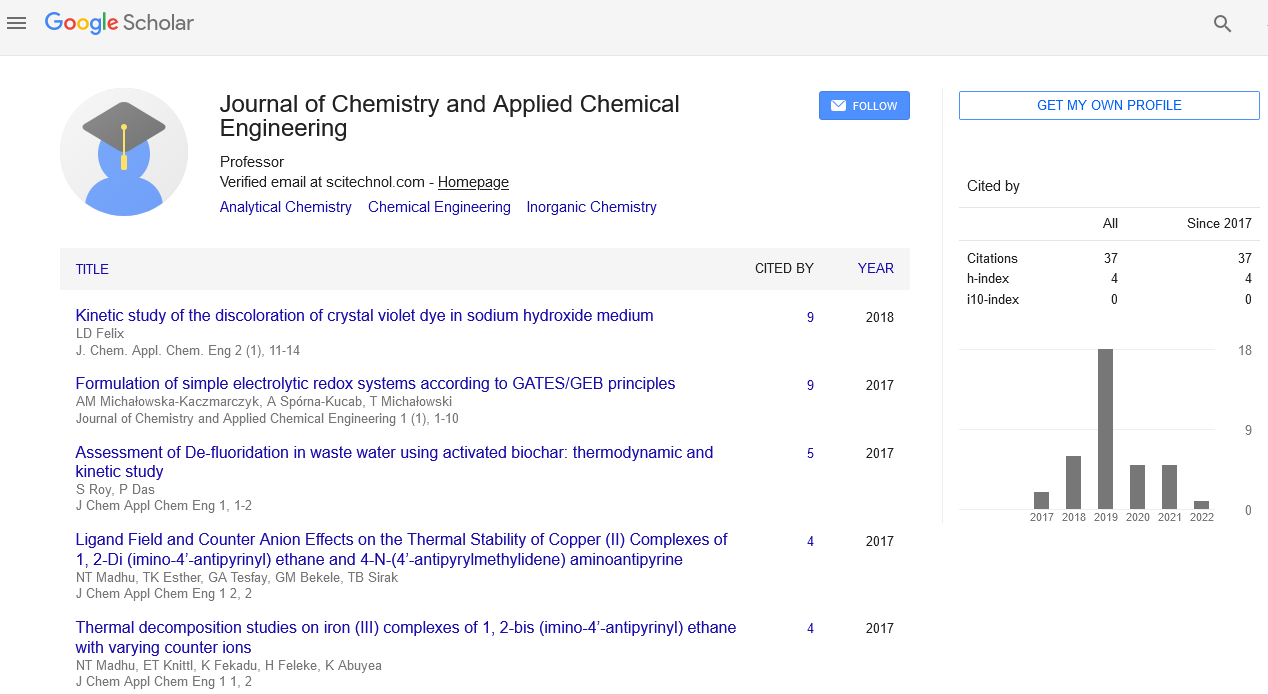Perspective, J Chem Appl Chem Eng Vol: 7 Issue: 3
Significant Properties of Polymer Particles and Its Structural Applications
Ruiew Latuada*
1Department of Chemistry, University of Fribourg, Fribourg, Switzerland
*Corresponding Author: Ruiew Latuada,
Department of Chemistry, University of
Fribourg, Fribourg, Switzerland
E-mail :ruiewla.tuada@gmail.com
Received date: 30 August, 2023, Manuscript No. JCACE-23-116795;
Editor assigned date: 01 September, 2023, Pre QC No. JCACE-23-116795(PQ);
Reviewed date: 15 September, 2023, QC No. JCACE-23-116795;
Revised date: 22 September, 2023, Manuscript No. JCACE-23-116795 (R);
Published date: 29 September, 2023, DOI: 10.4172/Jcace.1000035
Citation: Latuada R (2023) Significant Properties of Polymer Particles and Its Structural Applications. J Chem Appl Chem Engl 7:3.
Description
Polymer particles are a diverse and versatile class of materials with a wide range of applications, from everyday products to cutting-edge technologies. These particles are made up of long chains of repeating units, and their unique properties make them invaluable in various industries. One of the most significant advantages of polymer particles is their versatility and tailorability. Polymers can be synthesized to have a vast array of properties, from rigid and brittle to soft and flexible. By carefully selecting the monomers and controlling the polymerization process, scientists and engineers can design polymers with precise characteristics, including molecular weight, cross-linking, and functional groups. This makes them suitable for diverse applications ranging from food packaging to medical devices.
Polymer particles can exhibit impressive mechanical strength, making them ideal for a variety of structural applications. For instance, High-Density Polyethylene (HDPE) is a polymer renowned for its robustness, used in products such as water pipes and outdoor furniture. On the other hand, Polyvinyl Chloride (PVC) is another polymer known for its strength and durability in construction materials like pipes, windows, and doors. Many polymers have the added advantage of being lightweight. This property is particularly valuable in applications where reducing weight is essential, such as in aerospace and automotive industries. Lightweight polymer composites are used extensively to replace heavier metal components, enhancing fuel efficiency and reducing overall operational costs.
Flexibility and elongation
Some polymer particles are incredibly flexible and can undergo significant elongation without breaking. Elastomers, like natural rubber and synthetic rubber materials, have exceptional flexibility and are used in applications such as tires, seals, and gaskets. This property makes them suitable for withstanding dynamic mechanical stresses and providing shock absorption. Polymers can exhibit a wide range of thermal properties. Some polymers remain stable at high temperatures, making them essential for applications in extreme conditions. For example, Polytetrafluoroethylene (PTFE), commonly known as Teflon, is famous for its exceptional thermal stability and is used in cookware, electrical insulation, and as a lubricant.
Certain polymers are excellent electrical insulators. They have high resistivity, making them ideal for insulating wires, cables, and electronic components. Polyethylene and polypropylene are widely used in the electrical and electronics industry due to their excellent electrical insulating properties. In the medical and pharmaceutical fields, biocompatibility is a essential property. Many polymer particles can be engineered to be biocompatible, meaning they do not elicit harmful immune responses when in contact with living tissues. This makes them suitable for applications such as medical implants, drug delivery systems, and tissue engineering. Polymers can exhibit impressive chemical resistance, making them ideal for applications where exposure to various chemicals is a concern.
Conclusion
Polymer particles are a class of materials that have truly revolutionized our world. Their versatility, tailorability, and remarkable properties make them indispensable in various industries, from manufacturing and construction to healthcare and electronics. As researchers continue to develop new polymer formulations and manufacturing techniques, the potential applications of these materials are virtually limitless. The study and exploration of polymer properties will continue to be a driving force in materials science and engineering, propelling innovation and shaping our future. Polyethylene Terephthalate (PET) is widely used in the packaging industry due to its chemical resistance, while Polyvinylidene Fluoride (PVDF) is used in the chemical processing industry because of its exceptional resistance to corrosive chemicals.
 Spanish
Spanish  Chinese
Chinese  Russian
Russian  German
German  French
French  Japanese
Japanese  Portuguese
Portuguese  Hindi
Hindi 